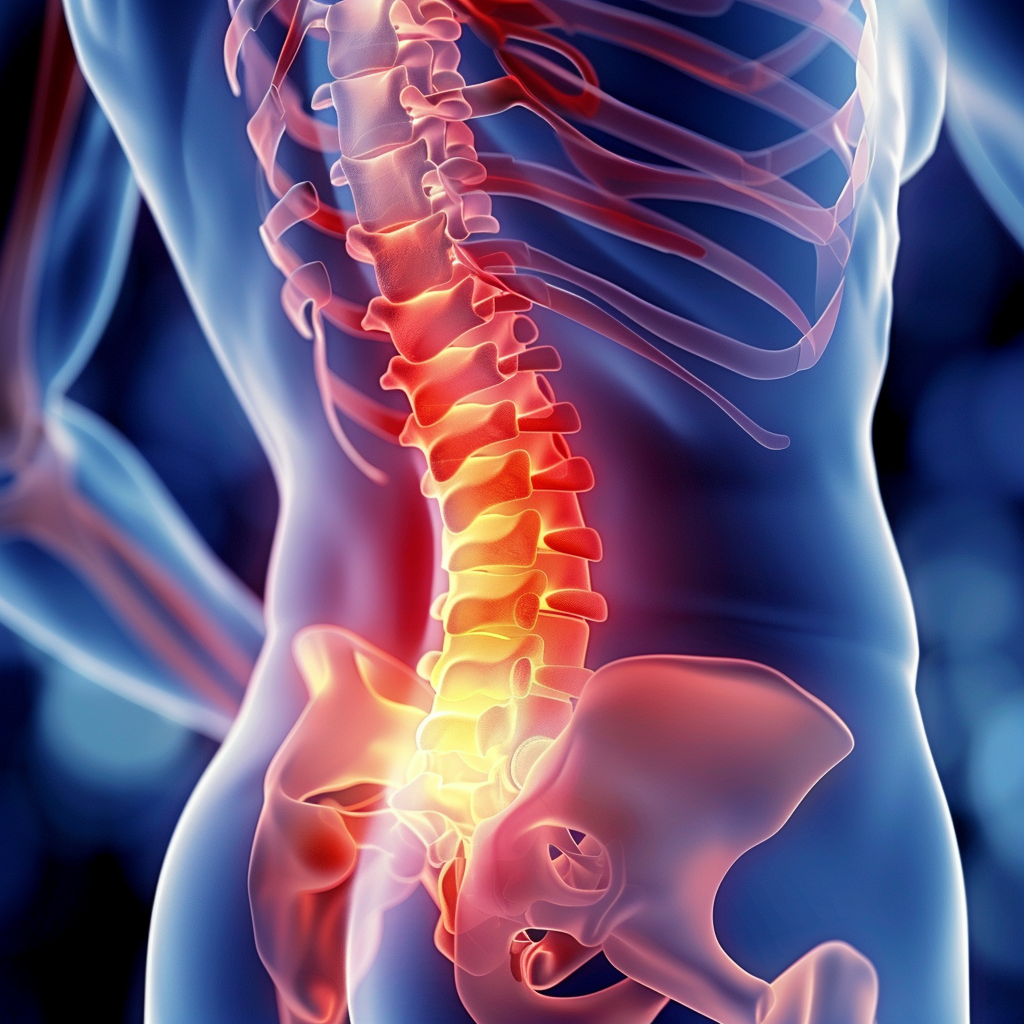Low back pain after a long day? Or you’ve been dealing with low back pain for a while now, and it’s starting to get in the way of your daily life.

Low back pain involves just one straightforward lifestyle change: regular exercise. Let’s explore how this can help you and what you can do to keep your back pain-free.
Understanding Low Back Pain
First, let’s get on the same page about low back pain. It’s that discomfort or pain between your legs and the bottom of your rib cage. Sometimes, it’s a dull ache; other times, it can be a sharp, stabbing pain. This pain can come with stiffness, muscle spasms, or even limit how much you can move around.
Common Causes and Risk Factors
Now, why does this pain happen? There are several reasons, such as muscle or ligament strain from lifting something heavy the wrong way, bulging or ruptured discs pressing on nerves, arthritis affecting your lower back, or even things like scoliosis or osteoporosis. Plus, not moving around much can lead to weak muscles and poor posture, contributing to back pain.
The Impact of Low Back Pain
Low back pain is not just about the physical discomfort. Low back pain can mess with your life. It can make simple activities like walking, bending, or lifting hard. It can also hurt your mental health, leading to stress, anxiety, and even depression. Plus, it can lead to missed workdays and lower productivity, which isn’t good for your career or wallet.
The Simple Lifestyle Change: Regular Exercise
So, here’s where the magic happens. For lower back pain, one of the best things you can do is exercise regularly. Exercise strengthens the muscles that support your back, improves your flexibility, and helps you maintain good posture. Let’s discuss the exercises that are especially good for keeping your back healthy.
Stretching Exercises
Stretching helps keep the muscles and ligaments in your back flexible, reducing the risk of strains and sprains. Here are some great stretches for your lower back:
- Hamstring Stretch: On your back, put one leg out in front of you bent and the other straight. Slowly lift the straight leg towards the ceiling until you feel a stretch in the back of your thigh. Hold for 20-30 seconds, then switch legs.
- Knee-to-Chest Stretch: Lay on your back with your knees bent. Bring one knee up to your chest and use your hands to pull it closer. Hold for 20-30 seconds, then switch legs.
- Cat-Cow Stretch: Get on your hands and knees. Arch your back towards the ceiling (cat pose), then lower it and lift your head and tailbone towards the ceiling (cow pose). Repeat several times.
Strengthening Exercises
Strengthening exercises build up the muscles that support your spine, helping to prevent injuries and maintain good posture. Try these:
- Bridges:Lay on your back with your feet level on the floor and your knees twisted. Crush your glutes and lift your hips up to the sky. Hold for a few seconds, then lower back down. Repeat 10-15 times.
- Planks: Lie face down what’s more, lift your body off the ground, supporting yourself on your lower arms and toes. Keep your body in an orderly fashion from head to heels. Hold for 20-30 seconds, gradually increasing the time as you get stronger.
- Bird-Dog: Start on your hands and knees. Extend one arm in front of you and the opposite leg behind you. Hold for a few seconds, then return to the starting position and switch sides. Repeat 10-15 times.
Aerobic Exercises
Low back pain aerobic exercises improve your overall fitness and help you keep a solid weight, which diminishes the burden on your lower back. Here are some options:
- Walking: A simple, effective way to stay active. Go for the gold 30 minutes of energetic strolling most days of the week.
- Swimming: This low-impact exercise works your entire body without stressing your joints.
- Cycling:Whether on an exercise bike or riding outside, cycling helps improve your cardiovascular health and strengthens your lower back and leg muscles.
Benefits of Regular Exercise for Low Back Health
Regular Exercise does wonders for your lower back health. Let’s break down the benefits:
Improved Muscle Strength and Flexibility
Practice reinforces the muscles that help your spine, including your core, back, and legs. Stronger muscles help keep your spine aligned and reduce the risk of injuries. Stretching exercises improve flexibility, making moving and performing daily activities easier without straining your back.
Enhanced Posture and Spinal Alignment
Good posture is crucial for preventing low back pain. Exercise helps strengthen the muscles that support proper posture, reducing the strain on your spine. When your muscles are strong and flexible, your spine stays better aligned and is less likely to experience back pain.
Reduction in Weight and Pressure on the Lower Back
Keeping a solid weight is fundamental for forestalling low back torment. Additional weight, particularly around your center, comes down on your lower back. Regular Exercise helps you manage your weight, reducing the strain on your back.
Better Overall Health and Well-Being
Exercise benefits more than just your back. It boosts your mood, reduces stress, improves sleep, and enhances your overall quality of life. When you feel better physically and mentally, you’re less likely to suffer from chronic pain.
Creating an Exercise Routine
Starting an exercise routine might seem daunting, but it’s easier than you think. The right approach can become an enjoyable part of your day. Here are some tips to get you started:
Tips for Getting Started with a New Exercise Routine
- Consult with a healthcare professional: Before starting any new exercise program, it’s a good idea to check with your doctor, especially if you have any health conditions.
- Set realistic goals: Begin with little objectives that you can reac improve the length and volume of your workouts overtime as you become more comfortable.
- Choose activities you enjoy: Find exercises.
That you like and look forward to makes it simpler to remain propelled and stay with your routine.
- Listen to your body: Pay attention to how you feel during and after Exercise. If something hurts, stop and consult a healthcare professional.
Recommended Frequency and Duration of Exercises
Go for the gold work-out schedule that incorporates extending, reinforcing, and high-impact activities to keep your back solid. The American Heart Affiliation suggests no less than 150 minutes of moderate-power high-impact practice or 75 minutes of energetic force vigorous activity each week, alongside muscle-fortifying exercises on at least two days out of every week.
Importance of Consistency and Gradual Progression
Consistency is basic to seeing the advantages of Activity. Make actual work an ordinary piece of your day to day daily schedule, and show restraint toward yourself as you develop fortitude and perseverance. Continuously increment the power and length of your exercises to stay away from overexertion and diminish the gamble of injury.
Additional Tips to Support Low Back Health
Other than customary Activity, there are other way of life transforms you can make to help your back wellbeing:
Maintaining Proper Posture Throughout the Day
Low back pain proper posture is essential for preventing low back pain. When sitting, keep your feet flat on the floor, your knees at a right angle, and your back straight against the chair. While standing, disseminate your weight equitably on the two feet and avoid slouching.
Ergonomic Adjustments in the Workplace and Home
Make ergonomic adjustments to your workstation to reduce strain on your back. Use a chair with good lumbar support, adjust your computer monitor to eye level, and use a keyboard and mouse to keep your wrists in a neutral position. Consider using supportive pillows and mattresses at home to maintain proper spinal alignment while sleeping.
Importance of a Healthy Diet and Adequate Hydration
A sound eating regimen and satisfactory hydration are essential for generally wellbeing, including your back. Eat a reasonable eating routine of natural products, vegetables, lean proteins, and entire grains to help muscle strength and bone wellbeing. Remain hydrated by drinking a lot of water all through the scope of the day.
The Role of Rest and Sleep in Back Health
Rest and rest are pivotal for recuperation and generally speaking prosperity. Hold back nothing extensive stretches of worth rest consistently to allow your body to fix and recover. Utilize strong pads and beddings to keep up with appropriate spinal arrangement while dozing, and practice great rest cleanliness to work on the nature of your rest.
Personal Stories and Expert Opinions
Hearing from others who have successfully prevented or managed low back pain through Exercise can be incredibly motivating. Here are a few personal stories and expert opinions:
Success Stories
- Emily: “I used to suffer from chronic low back pain due to my desk job. In any case, subsequent to beginning a normal work-out schedule that included stretching and strengthening exercises, I’ve been pain-free for over a year.”
- Dr. Patel: “Exercise is one of the best ways to prevent low back pain. It strengthens the muscles that support your spine and improves your overall health, reducing your risk of injury.”
Expert Opinions
- Physical Therapist Sarah: “Regular Exercise is crucial for maintaining a healthy back. It keeps your muscles strong and flexible, reducing the risk of strains and sprains.”
- Fitness Trainer James: “Incorporating exercises that target your core and lower back into your routine can have a major effect in forestalling lower back torment.“
Conclusion
In conclusion, Low back pain prevent low back pain doesn’t have to be complicated. By making a simple change to your lifestyle—regular Exercise—you can significantly reduce your risk of developing this common issue. Whether stretching, strengthening, or aerobic exercises, finding exercises you appreciate and integrating them into your routine can make a difference. So, what are you waiting for? Get moving and take control of your back health today!





